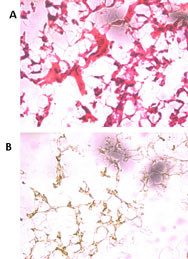UCH37 (UCHL5) Antibody (N-term)
Purified Rabbit Polyclonal Antibody (Pab)
- 产品详情
- 实验流程
- 背景知识
Application
| WB, IHC-F, E |
|---|---|
| Primary Accession | Q9Y5K5 |
| Other Accession | Q06AT3, Q9XSJ0 |
| Reactivity | Human, Mouse |
| Predicted | Pig, Bovine |
| Host | Rabbit |
| Clonality | Polyclonal |
| Isotype | Rabbit IgG |
| Calculated MW | 37607 Da |
| Antigen Region | 56-87 aa |
| Gene ID | 51377 |
|---|---|
| Other Names | Ubiquitin carboxyl-terminal hydrolase isozyme L5, UCH-L5, Ubiquitin C-terminal hydrolase UCH37, Ubiquitin thioesterase L5, UCHL5, UCH37 |
| Target/Specificity | This UCH37 (UCHL5) antibody is generated from rabbits immunized with a KLH conjugated synthetic peptide between 56-87 amino acids from the N-terminal region of human UCH37 (UCHL5). |
| Dilution | WB~~1:1000 IHC-F~~1:100~500 E~~Use at an assay dependent concentration. |
| Format | Purified polyclonal antibody supplied in PBS with 0.09% (W/V) sodium azide. This antibody is prepared by Saturated Ammonium Sulfate (SAS) precipitation followed by dialysis against PBS. |
| Storage | Maintain refrigerated at 2-8°C for up to 2 weeks. For long term storage store at -20°C in small aliquots to prevent freeze-thaw cycles. |
| Precautions | UCH37 (UCHL5) Antibody (N-term) is for research use only and not for use in diagnostic or therapeutic procedures. |
| Name | UCHL5 |
|---|---|
| Synonyms | UCH37 |
| Function | Protease that specifically cleaves 'Lys-48'-linked polyubiquitin chains. Deubiquitinating enzyme associated with the 19S regulatory subunit of the 26S proteasome. Putative regulatory component of the INO80 complex; however is inactive in the INO80 complex and is activated by a transient interaction of the INO80 complex with the proteasome via ADRM1. |
| Cellular Location | Cytoplasm. Nucleus. Note=Associates with the proteasome 19S subunit in the cytoplasm. Associates with the INO80 complex in the nucleus |
For Research Use Only. Not For Use In Diagnostic Procedures.
Provided below are standard protocols that you may find useful for product applications.
BACKGROUND
Covalent attachment of the C-terminus of ubiquitin to cellular proteins plays a role in a variety of cellular processes. Ubiquitin C-terminal hydrolysis is catalyzed by deubiquitinating (DUB) enzymes and is necessary for several functions, including liberation of monomeric ubiquitin from the precursors encoded by ubiquitin genes and recycling of ubiquitin monomers. There are 2 distinct families of DUBs, ubiquitin-specific proteases (UBPs) and ubiquitin C-terminal hydrolases (UCHs). Mayer and Wilkinson (1989) identified 4 distinct UCH activities from bovine thymus. All 4 were thiol proteases and had high-affinity binding sites for ubiquitin. Wilkinson et al. (1989) purified the predominant isozyme, UCHL3, and raised antibodies against it. By screening a human B-cell expression library with the antibodies, the authors isolated cDNAs encoding human UCHL3. Sequence comparisons revealed that the sequence of the predicted 230-amino acid human UCHL3 protein is 54% identical to that of UCHL1.
REFERENCES
M-P. et al. Proteomics. July; 9(13): 3609?622(2009).
Hu, R.M., et al., Proc. Natl. Acad. Sci. U.S.A. 97(17):9543-9548 (2000).
Lai, C.H., et al., Genome Res. 10(5):703-713 (2000).
终于等到您。ABCEPTA(百远生物)抗体产品。
点击下方“我要评价 ”按钮提交您的反馈信息,您的反馈和评价是我们最宝贵的财富之一,
我们将在1-3个工作日内处理您的反馈信息。
如有疑问,联系:0512-88856768 tech-china@abcepta.com.























 癌症的基本特征包括细胞增殖、血管生成、迁移、凋亡逃避机制和细胞永生等。找到癌症发生过程中这些通路的关键标记物和对应的抗体用于检测至关重要。
癌症的基本特征包括细胞增殖、血管生成、迁移、凋亡逃避机制和细胞永生等。找到癌症发生过程中这些通路的关键标记物和对应的抗体用于检测至关重要。 为您推荐一个泛素化位点预测神器——泛素化分析工具,可以为您的蛋白的泛素化位点作出预测和评分。
为您推荐一个泛素化位点预测神器——泛素化分析工具,可以为您的蛋白的泛素化位点作出预测和评分。 细胞自噬受体图形绘图工具为你的蛋白的细胞受体结合位点作出预测和评分,识别结合到自噬通路中的蛋白是非常重要的,便于让我们理解自噬在正常生理、病理过程中的作用,如发育、细胞分化、神经退化性疾病、压力条件下、感染和癌症。
细胞自噬受体图形绘图工具为你的蛋白的细胞受体结合位点作出预测和评分,识别结合到自噬通路中的蛋白是非常重要的,便于让我们理解自噬在正常生理、病理过程中的作用,如发育、细胞分化、神经退化性疾病、压力条件下、感染和癌症。







